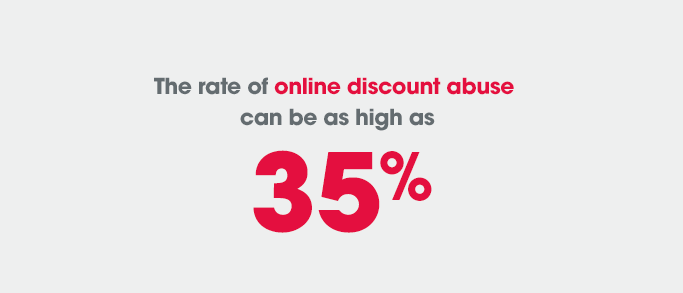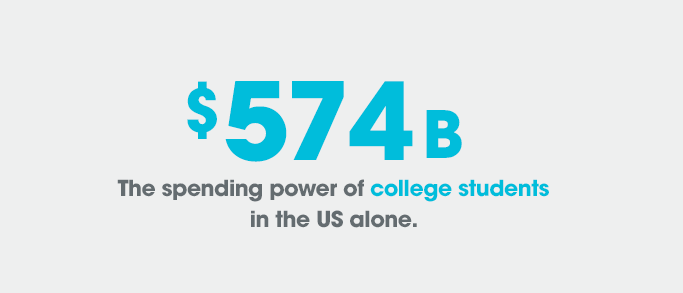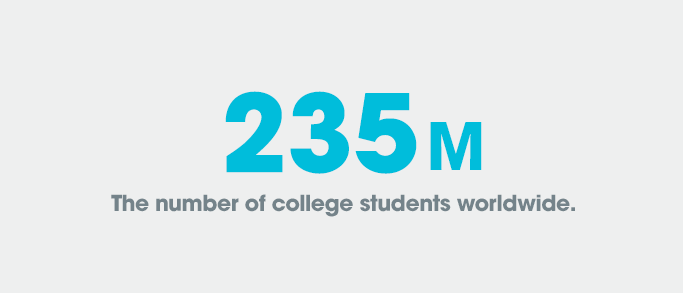Customer verification services confirm that an individual has a desired characteristic such as an affiliation with a particular group like the military or being a student. They can also be used to verify occupation or current employment. One highly valuable use of verification services is in targeted marketing campaigns, where they can help businesses identify and attract members of desired customer segments for a gated, exclusive offer.
Using Customer Verification Services for Market Segmentation
The main value of customer verification services is that they allow businesses to create gated offer programs that provide exclusive discounts or offers to specific, high-value groups with great purchasing power, such as:
- Military: There are 1.5 million military actively serving in the US, and when you include veterans, retirees, and family members, the group eligible for gated offers swells to 37 million with $1 trillion in spending power.
- Students: College students have a spending power of $560 billion in the US alone. Internationally, there are over a hundred million undergraduate and graduate college students.
- Teachers and Faculty: 6 million US educators spend $1.5 billion annually on their classrooms, and 88% of teachers actively seek out brands that value education and offer special perks to educators.
- Senior Citizens: Fifty-five percent of all depositors in financial institutions are seniors, and 77% of all assets in the United States are owned by individuals over 55, a group that totals more than 109 million. Seniors average five times the net worth of the average American.
- Employees: Employees are often eligible for exclusive promotions through corporate partnerships, employee purchase programs, freelance worker promotions, and special programs for government employees, but the offers are difficult to access.
- First Responders: First responders, like police, firefighters, and EMTs, are all influential members of local communities who provide invaluable services.
- Small Businesses: There are 30 million businesses in the United States.
There are two main benefits that customer verification services can provide in marketing to these segments:
Using Verification Services for Customer Acquisition
Customer verification services are an essential step in bringing new customers into a brand through a targeted gated offer program. For example:
- Tableau uses SheerID to provide their interactive data visualization and BI software to verified college students in 44 countries for free. Not only do the students graduate with a proficiency in their software, they turn into paying customers who bring that expertise—and Tableau—into the professional world.


Customer verification services can increase customer acquisition by helping a brand:
- Provide an exclusive offer to a specific group (such as the military), which creates a positive brand impression in the minds of the group’s members.
- Meet the criteria of manufacturers, vendors, or parties who require that services or products are only provided to customers in specific groups.
- Align in-store, online, and mobile customer journeys.
- Create exclusive promotions and segmented email marketing campaigns that personalize the customer experience.
- Identify and stop discount fraud by using eligibility verification as a preventative measure.
Using Customer Verification Services for Loss Prevention
The rate of online discount abuse can be as high as 35%—meaning that one-third of all gated offers are redeemed by ineligible customers. Customer verification services can mitigate the negative impact of discount abuse by preventing:
- Employee Discount Abuse: When employees share a discount with friends and family who are not technically part of the program. For example, a sportswear company may provide its employees with “examplecode321” for a specific program with one of the their partners.
- POS Discount Fraud: When a retail employee encounters an issue when validating a customer at checkout, doesn’t feel empowered to address it, and grants the customer access to the gated offer through a manual override at the cashier.
- White Lie Redemption: When a customer has an out-of-date credential. For example, a student who graduated 10 years ago but still has an active .edu email address.
Types of Customer Verification
There are two types of verification services—attribute verification and identity verification:
- Attribute Verification is an emerging system of online verification designed to instantly verify the credentials of an individual or organization. Attribute Verification is performed by accessing an authoritative data source, as well as multiple verification methods, including IP-based verification and SSO-based validation.
- Identity Verification is used by businesses to ensure that users or customers provide information that is associated with the identity of a real person. The service may verify the authenticity of physical identity documents such as a driver’s license or passport—called “documentary verification,”—or it may verify identity information against authoritative sources, such as a credit bureau or government data—called “non-documentary verification.”
Within these two types, there are several distinct ways of actually verifying a segment or a person’s identity:
- Asset Review is conducted by document review specialists to confirm that the document uploaded is a valid document type and includes the data required for verification.
- Instant Verification Systems compare data against one or more data sources, providing confirmation that the field data submitted matches an authoritative data source. These systems can take advantage of different methods for providing quick, accurate verification. They typically:
- Verify credentials against an authoritative data source. Only by using multiple authoritative data sources—such as the Office of the Registrar for university students—can instant verification deliver accurate and reliable results for every customer. To increase accuracy and reliability, it’s critical to have multiple sources of information.
- Verify instantly within your transaction process. Preventing fraud and creating a stellar customer experience are no longer mutually exclusive. When building instant verification within a transaction process, credentials can be validated with sub-second latency and within a brand experience. This simple process increases conversion and sparks the next level of engagement, loyalty, and value.
- Use unique reward codes. The best way to control how and when a gated offer can be used once a person is verified is with auto-generated unique offer codes. Some systems allow you to control how often a code is used. For example, if you have a one-time offer, you can create a single-use code or set a number of transactions during a time period (e.g. “get your next 3 purchases at 20% discount”).
- Validation is based on a match of submitted organization ID and email address domain against a configured set of valid domains for that organization ID.
- Email loop can be used in conjunction with validation or by itself. This type of verification is based on successful receipt and click-through of a tokenized link delivered to a specified email address.
- IP address is based on detecting whether the IP address that a verification subject is coming from is associated with a specific organization ID, such as a university.
- SSO (single sign-on) verification is based on a successful login to the school portal using school-provided user credentials.
- Honor system always indicates verification is successful when data field requirements are met.


Issues with Traditional Customer Verification Methods
Customer verification services are the practice of verifying that a customer meets an organization’s eligibility criteria in order to redeem a gated offer. Traditionally, there are three types of customer verification services that brands have used to both confirm a customer is eligible for a gated offer and to protect the exclusivity of their promotions:
Show and save: Many retailers have long used this approach when offering specialized discounts. They may offer a percent off their product to students or the military, and to redeem that offer, the customer has to show a student ID, military identification, or other credentials in person. This method is simple to setup, requires no IT integration, and comes at no cost to the company. These characteristics make “show and save” an appealing option for many organizations. However, there are several issues with this model to be aware of:
- False Identification: Many people have IDs that don’t have an expiration date. These IDs allow customers to present themselves as members of a group the might no longer belong to, and fraudulently redeem offers they aren’t eligible for.
- Human Error: The burden of verification falls on the shoulders of sales associates or customer service representatives, and problems can arise when they’re not trained to recognize the authenticity of dozens of forms of identification that prove eligibility.
- In-Person Only: This is the greatest limitation. If you are trying to reach college students or military personnel, you may not have a brick-and-mortar location near their campus or military base. To overcome this limitation, some retailers have created an in-house system that makes customers go through an arduous, time-consuming process of faxing, sending, or scanning paperwork for approval before they can complete their online purchase.
Email Loops: Many brands use this method today, which requires a customer to enter in their email address, log into their email account, and click a link sent by the brand to verify who they are. The customer is required to have an email address with a specific email domain (like .edu, .mil, or a corporate email address) to prove their eligibility for a specific type of offer. Many organizations choose this option as it makes online verification relatively simple and discourages discount abuse more effectively than the honor system.
Verification Against Membership Groups or Communities: There are two forms of this verification method: card-based or digital. The card-based method is also a variation on the “show and save” model. There are membership programs that offer their members physical cards that “prove” they are college students, affiliated with the military, or eligible for other kinds of offers. Members pay to join these groups and receive their identification cards. In most cases, members must log into a portal if they want to apply discounts to online purchases.


SheerID’s Digital Customer Verification Platform
SheerID has identified and built its technology to remove the pain-points with the traditional methods listed above. We offer:
- Authoritative Verification: This verification service leverages authoritative data sources to instantly confirm and verify the eligibility of exclusive customer groups.
- Document Review: Unlike clunky in-house solutions that require customers to fax, email, or submit copies of credentials for a lengthy approval process, document review is online, quick, and streamlined to provide the best customer service experience possible.
- Complete Control: During the implementation process, SheerID clients decide both who is eligible for their programs and what information they would like to collect during the verification process.
- Seamless Customer Experience: SheerID clients determine where verification should take place in the customer journey so it doesn’t disrupt the normal buying or registration process.
- Data Security: SheerID provides businesses with flexible privacy controls and 2048-bit RSA encryption for the highest in security for businesses and consumers.
- Customer Intelligence: SheerID doesn’t remarket to your customers. You own the customer data gathered by SheerID so you can market more effectively with personalized content for the customer moving forward.






